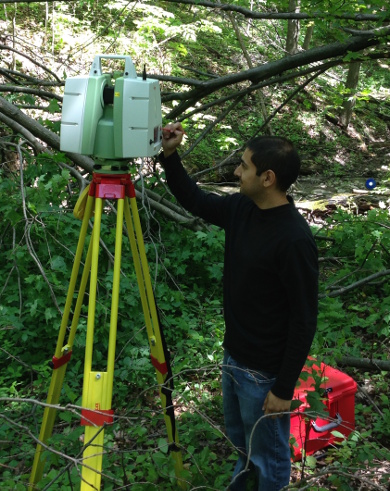People

The Geomorphometry & Hydrogeomatics Research Group (GHRG) is led by Dr John Lindsay at in University of Guelph's Department of Geography. We develop innovative solutions to allow practitioners and researchers to solve spatial problems involving topography. Topography is the dominant control on the spatial distribution of many natural phenomena of interest. Topography affects the flow paths taken by runoff and the abundance of near-surface water at a location. It influences climatic variables such as temperature, solar radiation, and exposure to wind. Each of these environmental conditions (i.e. the abundance of water, energy, heat, wind, etc.) in turn affects soil development, the spatial distributions of flora and fauna, and the flux of fine sediment, essential nutrients, and contaminants in catchments. Our goal in the GHRG is to study the ways in which topographic attributes, including surface shape and orientation, roughness and surface texture, and relative topographic position, can be better characterized using digital elevation models (DEMs). As part of this motivating goal, we develop state-of-the-science open-source geospatial analysis software to help practitioners and researchers around the world to better utilize DEM data sets.

Current Student Members
- Marina Coric (MSc, start F24) Topic to be determined.
- Abbey Papadimitriou (MSc, start F24, co-advised with Prof. A. Berg) Topic to be determined.
- Yannan Wang (PhD, start F24) Topic to be determined.
Former Post-docs
- Ehsan Roshani (2013-2014; with Berg)
Former Graduate Students
- Garnet Owen (MSc 2023) A Novel Hybrid Breaching Solution for Modelling Surface Drainage Patterns in Altered Landscapes Using LiDAR.
- Erin Burton (Msc 2023; co-advised with Dr. Adam Gillespie, SES) The Effect of Surface Complexity and Organic Matter on Crop Yield in Southern Ontario, Canada, with consideration for Precipitation, Crop Type, and Soil Texture.
- Laura Lisso (MSc 2023; co-advised with Dr. Aaron Berg) Examining the Relationships Between Topography and Suitable Agricultural Land for Specialty Crops.
- Daniel Newman (PhD 2022) Development and assessment of spatially heterogeneous scaling methods for multiscale topographic characterization.
- Nigel Van Nieuwenhuizen (Msc 2021) Challenges in LiDAR DEM preprocessing: Anthropogenic embankment removal and the hydrological impacts of smoothing.
- Anthony Francioni (MSc 2019) An analysis of DEM generalization techniques for hydrological flow path modelling.
- Simon Gudim (MSc 2019) Impoundment Size Index (ISI): The use of potential impoundment size for the characterization of topographic incision in DEMs.
- Kevin Roberts (MSc 2019) An analysis of ground-point classifiers for terrestrial LiDAR.
- Daniel Newman (MSc 2018) The measures and applications of topographic position and surface roughness in geomorphometry.
- Christopher Mallon (MSc 2017; with Yang) Hydrologic-economic modeling of the cost-effectiveness and targeting of nutrient management in the Gully Creek watershed, Ontario
- Melanie Chabot (MSc 2016; with Berg) Characterizing Agricultural Surface Roughness Using a Terrestrial Laser Scanner: Implications for Soil Moisture Retrieval from Remote Sensing Products.
- Dr. Rashaad Bhamjee (PhD 2015) Low-flow hydrology in Canadian headwater areas.
- Kathryn Woodrow (MSc 2014; with Berg) Isolated catchment mapping in Southwestern Ontario morainal landscapes.
- Colleen Fuss (MSc 2013; with Berg) Increasing digital elevation model resolution using multi-observation, quad-polar, RADARSAT-2 imagery and data fusion techniques.
- Beau Ahrens (MSc 2012) Landscape characterization using digital elevation models.
- Sarah Peirce (MSc 2012) Characterization of ephemeral streams using electrical resistance (ER) sensors.
- Kimberly Dhun (MSc 2011) Application of LiDAR DEM to the modelling of surface drainage patterns in human modified landscapes.
- Rashaad Bhamjee (MSc 2010) Assessing spatial and temporal variability of ephemeral streamflow in Southern Ontario.
Former Undergraduate Students*
- Matthew Pineda (NSERC-funded Undergraduate Research Assistant S23). Research support in geomorphometry (geomatics).
- Kalum Delaney (BSc Independent Study W22). Testing the viability of three machine learning classification tools to create an off-terrain object mask for the Copernicus DSM over Southern Ontario.
- Harison Hendricks (BSc Independent Study W22). Characterization of lake bathymetry in northern-eastern Saskatchewan.
- Yannan Wang (BSc Independent Study W22). Characterization of lake bathymetry in northern Saskatchewan.
- Garnet Owen, NSERC-funded Undergraduate Research Assistant S20.
- Claire Haar, Undergraduate student volunteer.
- Nicholas Puopolo, Undergraduate student volunteer
- Rachel Broders (NSERC-funded Undergraduate Research Assistant S19). Airborne LiDAR data handling in support of geomorphometry.
- Evan Fortushniok (BSc Independent Study W19) Assessing the potential using airborne LiDAR datasets to extract sidewalk corridors within urban centers of London Ontario.
- Liam Clark-Squire (BSc Independent Study W18) Identifying embankments within a high-resolution digital elevation model derived from LiDAR data.
- Liam Clark-Squire (NSERC-funded Undergraduate Research Assistant S17)
- Anthony Francioni (BA Independent Study W17) Assessing the techniques for removal of small-scale noise in LiDAR DEMs.
- Elizabeth George (BSc Independent Study W17) The effects of data reduction on digital elevation models.
- Kevin Roberts (BA Independent Study F16) A Comparison of Ground-Point Separation Techniques Applied to Terrestrial LiDAR Data.
- Jordan McDonald (BSc Independent Study F16) Scaling Effects on the Correlation between Soil Characteristics and Measures of Topographic Position.
* If you are a Guelph Geography student (any major) and are interested in carrying out an independent study in the GHRG, please contact Prof. Lindsay. See Undergraduate Opportunities for more information.
Interested in joining the Geomorphometry & Hydrogeomatics Research Group?


